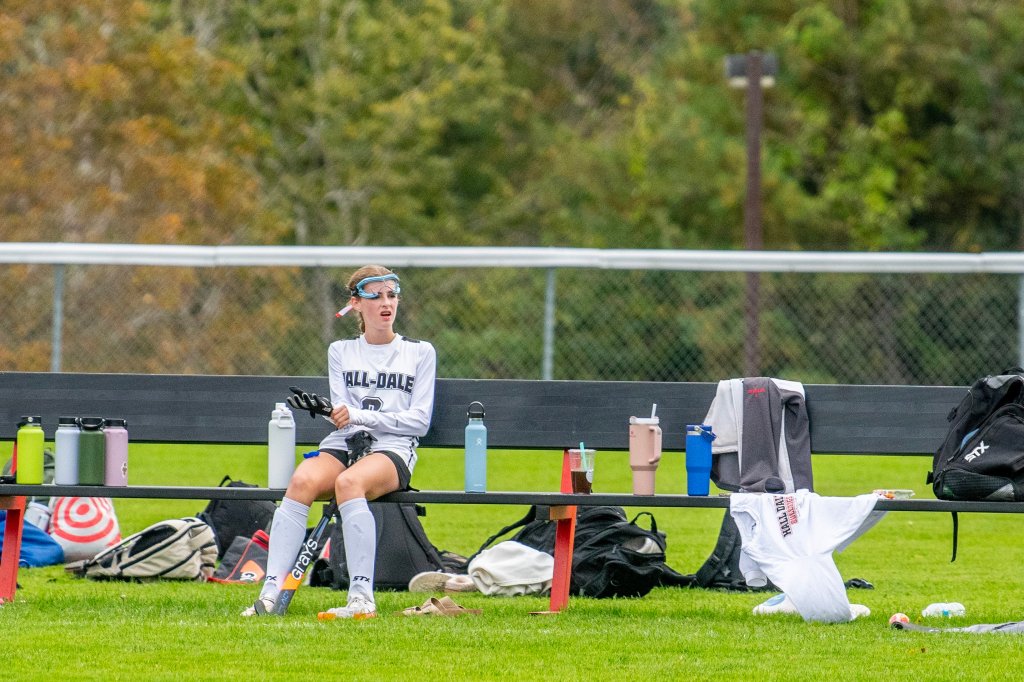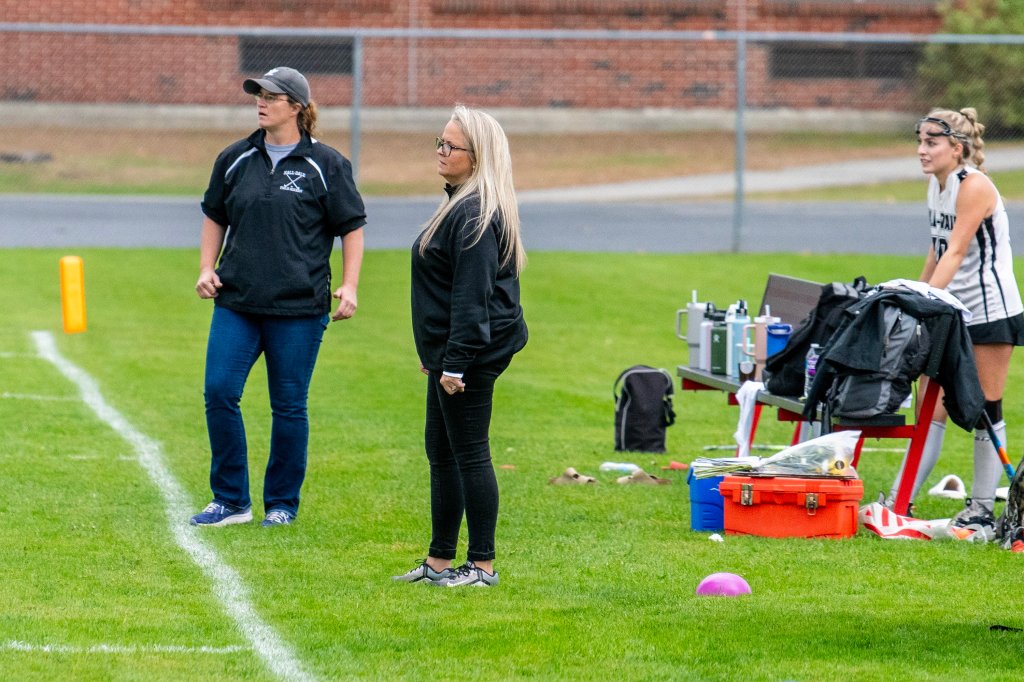Krista Chase first saw the warning signs in 2009, when she left as the field hockey coach at Cony High in Augusta. Filling three separate teams for varsity, junior varsity and freshmen was normally an easy task. Not anymore.
“Around that time, freshmen teams started to go away,” she said. “Not a crisis, but that was definitely a shift.”
That shift has only worsened. Now the head coach at Mt. Ararat in Topsham, Chase has a hard time finding games for her junior varsity players. Other schools don’t have enough players for full JV teams.
“I have been screaming that every chance I can get,” she said. “I’m really worried about the state of field hockey in Maine right now. Maybe it will recover, maybe this is just a phase. … Maybe it’s just a blip, but I’m worried it’s not.”
While participation in most high school sports in Maine is in decline, the downward trend in field hockey is striking. The number of high school field hockey players in the state fell from 2,250 in 2017 to 1,789 in 2021, a drop of 20.5%, according to participation figures provided by the Maine Principals’ Association. Nationally, according to data from the National Federation of State High School Associations, turnout for girls’ field hockey dropped 6.7% in those years as is now played in two fewer states.
Among fall sports in Maine, field hockey has had a steeper drop than boys’ soccer (11.4%), girls’ soccer (6.2%) and football (10%).

Hall-Dale field hockey goalie and captain Jade Graham rallies teammates at the end of a timeout during an Oct. 11 game against Mountain Valley in Farmingdale. Joe Phelan/Kennebec Journal
“I remember years early on when I first started coaching, we had 50 girls trying out,” said York Coach Barb Marois, whose team has won 12 Class B South titles and four state championships since she began coaching in 2000, but is now down to 16 players. “Now we’re just a little, little bit.”
Gorham Coach Becky Manson said the “sport is in danger.” Chase shares that fear.
“For those of us who have dedicated a lot of our lives to working with kids and building kids through sports, it does feel like a bit of a crisis,” she said.
The Maine Field Hockey Association, led by current and former high school coaches, has proposed an initiative that could offer a solution. The group has spoken with the MPA’s field hockey committee about adding short-sided field hockey, either 7-on-7 or 8-on-8, to give struggling programs a better chance to field teams. MPA Executive Director Mike Burnham confirmed that the committee is continuing to look at the possibility, as athletic directors take the temperature of their respective programs.
Donna Jordan, the MFHA liaison to the MPA, said the field hockey committee will meet next week.
“I’m hoping that we’ll hear something at our next meeting,” Jordan said. “If it’s not in the next meeting, we’ll meet again in December, and I would expect there would be something, a yay or nay.”
Field hockey is traditionally played with 11 players on the field, including the goalie, and Jordan said “14, 15 kids is what people probably are comfortable with” in order to field a team. The MPA adopted eight-man football in 2019 and eight-man soccer this year in light of dwindling roster sizes.
“If I had a team that was down to 12 players … it would be nice that those girls have the opportunity to play that small-sided game so they can continue to play the game they absolutely love,” said Jordan, who coached at Piscataquis and Boothbay before retiring in 2020. “I think it’s a great step to help struggling teams. Many coaches have said … it would save their program.”
One such program is Hall-Dale, which competes in Class C. The Bulldogs have just 13 players, and played a game Wednesday with 12 because of an injury.
Hall-Dale Athletic Director Chris Ranslow said that while 11-on-11 is the goal, short-sided field hockey could be a game-changer.
“We only have a maximum of two subs if everyone is available and healthy,” Ranslow said. “(Short-sided field hockey) would benefit us in the short term, because next year, we’re projecting to be (lower in numbers).”
Those in the sport cite a variety of reasons for the drop in numbers. Jordan said declining enrollments have been the biggest factor. Brunswick Coach Carrie Sullivan pointed to the pandemic, which caused middle school numbers to shrink.
Windham Coach Cory DiDonato said she’s noticed more potential players choosing jobs post-COVID than she did before.
Skowhegan Coach Paula Doughty, whose program has been the state’s best for 25 years, with 17 Class A championships since 2001, now has 26 players after having close to 40 in 2018. She said the varsity game has never been better given the skill level of players, but declining numbers have had a big effect at the junior varsity level.
“I used to have 20 varsity, 20 JV and 20 freshmen. The varsity kids were the most competitive group, but the other 40 kids played for the love of the game,” she said. “Today, what I see is that if a kid doesn’t make varsity their freshman or sophomore year, they quit, or their parents don’t want them to waste their time. … The varsity teams in this state are better than they’ve ever been before. What’s struggling for numbers are the JV programs.”

Gorham field hockey players celebrate a goal against Sanford early in their Sept. 27 game in Gorham. Brianna Soukup/Portland Press Herald
Coaches also pointed to volleyball, which has risen in popularity and given girls who might otherwise play field hockey another sport to choose. Volleyball participation in Maine rose 14.5% from 2017 to 2021.
“We had a big eighth-grade group last year, and five of them are playing volleyball right now,” Manson said. “I don’t want to totally blame it on that, but volleyball is a huge factor, especially for Gorham, because it’s such a big program and the coaches are great and they’re very successful.”
Coaches mention that field hockey can be at a disadvantage because the sport isn’t available in some communities until middle school. By then, some athletes have already chosen a different primary sport.
“The well of kids that we get to choose from is just smaller, because it’s not available at a young age, so people aren’t playing when they’re young,” said DiDonato, the Windham coach. “It hasn’t ever been the sport. Soccer has been the sport, especially in southern Maine.”
Coaches have taken it upon themselves to create youth programs in an attempt to get kids playing at earlier ages. Mary Beth Bourgoin, Winslow’s longtime coach, has kept numbers in relatively good shape since 2002 by running a youth program and, recently, a travel team. Bourgoin said she has 35 players in her youth program. She had 22 on her travel team last season and 16 this year.
“For years, it was just Sunday rec and (working on) skills and having fun, skills and having fun,” Bourgoin said. “It’s not enough anymore; for some reason, parents want more. So last year, I started a travel team. That seems to have helped somewhat.”
Starting a youth or travel program isn’t easy, though. Varsity coaches are often the ones tasked with setting up and then running the teams. It can be a struggle to find the time.
“I run all the programming in our district, but that’s a lot to ask of a coach,” said Chase, of Mt. Ararat. “I’m pretty passionate about it … so for me, it’s totally worth it. But it is exhausting. It’s this whole other job.”
With numbers in decline, some schools have had to form co-ops or play JV schedules, if they haven’t stopped playing completely. Portland and Deering formed a co-op in 2019, and South Portland and Westbrook did the same in 2022. Maranacook had to combine with Winthrop this fall.

Spruce Mountain’s Maddie Grimaldi attempts to hit the ball past Winthrop/Maranacook’s Lauren Miller during a Sept. 25 game in Winthrop. Maranacook, citing low participation numbers, joined Winthrop as a co-op program this fall. Andree Kehn/Sun Journal
Maranacook Athletic Director Brant Remington quickly realized, after the graduation of a large group of seniors, that there would be no way to keep the program going on its own.
“The last couple years, we had one large class of girls,” he said. “So last year, we graduated 12 girls out of a roster of 19. … (We) basically came to the consensus that field hockey is pretty much done at the high school and middle school.”
Waterville has 15 players on its roster, but with seven freshmen is playing only a JV schedule. Athletic Director Heidi Bernier said a short-sided option would have made varsity play a possibility.
“Had the MPA started (smaller-sided field hockey) this year, we would’ve tried to do a 7 versus 7, or maybe 8 versus 8,” she said. “We probably would’ve tried to do that, had we got together enough games on a schedule as an MPA-sponsored varsity sport.”
While short-sided field hockey would help teams get on the field, there is still the issue of fewer and fewer girls choosing to play field hockey, a sport that has a strong tradition in the state and a successful track record of sending players on to college programs.
The trend is felt by teams both large and small, and coaches – and even players – often find themselves recruiting.
“Some (athletes) don’t enjoy the sports that they’re playing and they end up quitting, so I feel like that’s the time to bring them over to field hockey,” said Windham senior Sam Bell, who persuaded former soccer player Alyssa Conley to pick up the sport. “It’s just getting the word around. … (I tell) them it’s enjoyable, it’s fun.”
There’s concern about the future. There’s still hope, however, that the sport will survive.
“I can’t imagine a world in my life where there’s not field hockey in Maine,” Chase said. “What I worry about is the league shrinking, competition shrinking, losing players who could be really good at field hockey. But the optimist in me cannot imagine it would ever go away.”
Send questions/comments to the editors.
















Success. Please wait for the page to reload. If the page does not reload within 5 seconds, please refresh the page.
Enter your email and password to access comments.
Hi, to comment on stories you must . This profile is in addition to your subscription and website login.
Already have a commenting profile? .
Invalid username/password.
Please check your email to confirm and complete your registration.
Only subscribers are eligible to post comments. Please subscribe or login first for digital access. Here’s why.
Use the form below to reset your password. When you've submitted your account email, we will send an email with a reset code.